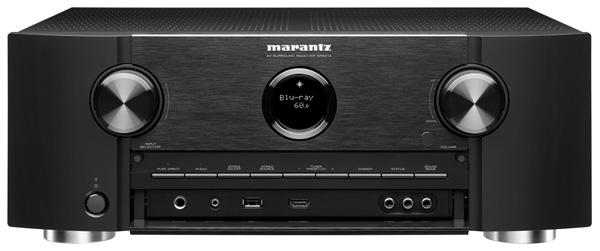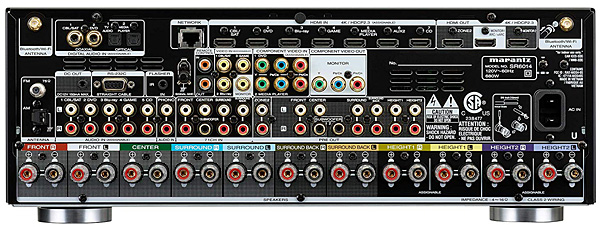Marantz SR6014 9.2-Channel A/V Receiver Review

AT A GLANCE
Plus
Punchy, music-friendly sonics
Flexible speaker configuration options
HEOS wireless streaming
Minus
Limited custom installation features
Non-backlit remote
THE VERDICT
Marantz’s SR6014 proves that an A/V receiver can deliver both great music performance and the latest home theater audio formats, all at an affordable price.
Marantz has been a premium audio brand for more than 65 years, so it makes sense that the company's A/V receivers focus squarely on audio performance, rather than racking up loads of home theater bells and whistles only a few will use. But while it's clear that Marantz's offerings tip the scale a bit more toward music enthusiasts than the custom installation scene, the new SR6014 isn't some stripped-down product aimed at hair shirt-wearing audiophiles. Instead, it's a bang-up-to-date home theater receiver that ticks off all the boxes for most-wanted surround sound features.
 With some key A/V receiver manufacturers falling under the same ownership umbrella—Marantz and Denon are both part of Sound United, while Onkyo acquired Pioneer's home entertainment wing in 2015—you might expect that the offerings from each brand would start to look pretty similar under the skin. While we have seen evidence of consolidation, it's also clear that each brand continues to maintain its identity by focusing on different design goals. With the SR6014, for example, basic multi-zone and custom installation features are provided, but Marantz's decades-long emphasis on audio quality means you also get features like the company's high-performance Hyper Dynamic Amplifier Modules (HDAM).
With some key A/V receiver manufacturers falling under the same ownership umbrella—Marantz and Denon are both part of Sound United, while Onkyo acquired Pioneer's home entertainment wing in 2015—you might expect that the offerings from each brand would start to look pretty similar under the skin. While we have seen evidence of consolidation, it's also clear that each brand continues to maintain its identity by focusing on different design goals. With the SR6014, for example, basic multi-zone and custom installation features are provided, but Marantz's decades-long emphasis on audio quality means you also get features like the company's high-performance Hyper Dynamic Amplifier Modules (HDAM).
I have long felt that the sweet spot in any brand's A/V receiver lineup lies a step or two below its flagship model. At those levels, you can still expect to get key features, but at a fraction of the price of top-of-the-range offerings. This is certainly true with the SR6014, a model that's actually better-equipped in some areas than Marantz's somewhat older, SR8012 flagship, which costs twice as much. Yes, the SR8012 has an 11 x 140-watt onboard amplifier (8 ohms, 20Hz-20KHz, 0.08% THD, 2 channels Driven), while the SR6014 features a 9 x 110-watt amp (spec'd using same measurement conditions). But as I'll discuss in a bit, the SR6014 uses some clever speaker-configuration juggling to make that difference less of an issue than it might at first seem.
Marantz was one of the first brands to deliver IMAX Enhanced A/V receivers via a firmware update made available in late 2018. With the SR6014, that certification is enabled out of the box. IMAX Enhanced not only sets audio and video performance standards for both A/V receivers and displays, but when used with enhanced content, it can make temporary adjustments to your audio and picture settings to "deliver content as the filmmaker intended." While that idea is compelling, IMAX Enhanced content so far has not kept up with the hardware—as I write this there are just three IMAX Enhanced Ultra HD Blu-rays, all documentaries from IMAX, and a couple of movies streaming on FandangoNow.

With eight HDMI 2.0b inputs and a host of analog audio and video inputs, the SR6014 can connect to just about any gear you have on-hand. There's even a moving magnet phono input for your turntable. What's not included is HDMI inputs that fully conform to the upcoming HDMI 2.1 standard. While it's true that 8K and 10K video formats will require the wider pipe that HDMI 2.1 provides, it's going to take at least several years for mega-resolution formats to become available. As it stands, the SR6014 is fully compatible with any video signal you're likely to encounter now and for years to come, and also provides a subset of HDMI 2.1 features including Enhanced Audio Return Channel (eARC) and Auto Low Latency Mode (ALLM).
Sister brands Marantz and Denon have bundled their online audio streaming and wireless connectivity functions into an ecosystem called HEOS, which includes most of the popular music streaming services such as Tidal, Pandora, and TuneIn Radio. (Spotify Connect is also supported but is controlled via the native Spotify app.) Those services can be accessed by running the HEOS app on a smartphone or tablet linked wirelessly to the SR6014. For more basic receiver functions, you can download the confusingly named Marantz 2016 AVR Remote app, which I can confirm also works just fine with the company's 2019 products! It would be nice if Marantz could find a way to integrate the HEOS and receiver control functions into a single app, as it would eliminate the need to flip back and forth between two apps to keep everything under control.
While the apps available to run the SR6014 are more than adequate, I generally prefer the tactile buttons of a dedicated remote over an app running on a touchscreen device when watching movies in a dark room. The SR6014's remote is nicely laid out and easy to use, but it also lacks any sort of button illumination to make dark room operation easier.






























































